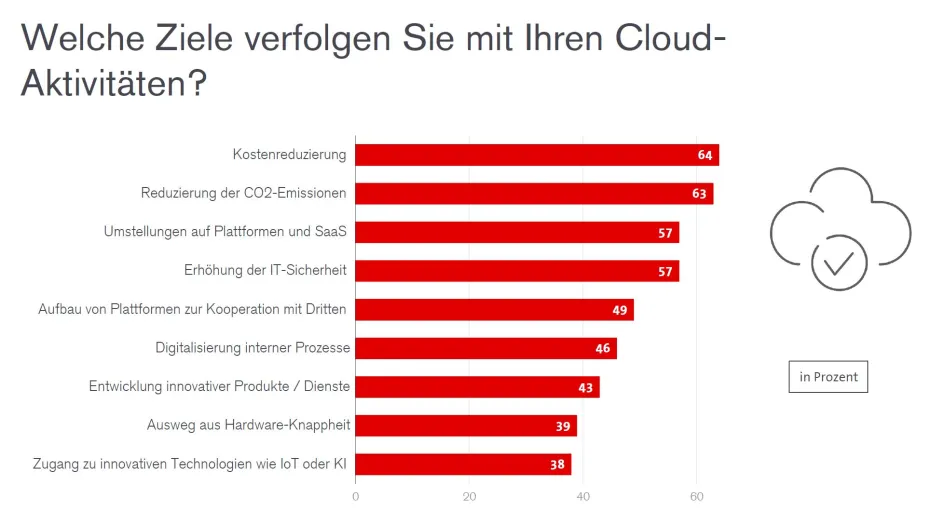Clouds for Future: How sustainability in the cloud supports the fight against the climate crisis

Timo Ohlenbostel
Product Manager
Cloud technology has developed rapidly in recent years and is now a central element of digital development. However, in addition to the numerous benefits that the cloud offers, sustainability is also playing an increasingly important role. In this article, you will learn how cloud technologies can help reduce your company's environmental footprint and support the fight against the climate crisis.
The environmental impact of the IT industry
The IT industry is one of the largest energy consumers in the world. According to a study by McMaster University in Canada (*), emissions from the IT industry account for around 3.5% of global CO2 emissions. It is expected that this share could rise to 14% by 2040. In comparison, the civil aviation industry's share of global CO2 emissions before the COVID-19 pandemic was around 2.5%.
(*) "Assessing ICT global emissions footprint: Trends to 2040 & recommendations" by Lotfi Belkhir and Ahmed Elmeligi, McMaster University Canada
The constantly growing demand for computing power and storage capacity is leading to an increase in data centres and thus also to increased energy consumption and CO2 emissions. Added to this is the immense water consumption for cooling data centres and the production of hardware, which has a negative impact on the environment.
The importance of sustainability in the cloud
In view of the growing importance of environmental protection and sustainable action, more and more companies must recognise the need to make their IT infrastructure more environmentally friendly.
Cloud technology offers a promising opportunity to achieve these goals. Compared to traditional on-premise infrastructures, where IT resources are operated locally in a company's own data centres, cloud solutions can significantly reduce energy consumption and CO2 emissions. One of the reasons for this is that cloud providers generally operate more efficient and energy-optimised data centres, which enable their customers to achieve a better energy balance.
Environmental benefits of the cloud
Transitioning from on-premise infrastructures to cloud solutions offers a number of environmental benefits:
- Energy efficiency: Cloud data centres are generally optimised for energy efficiency and use state-of-the-art technologies to minimise energy consumption. This results in a better energy balance for companies that operate their IT infrastructure in the cloud.
- Resource optimisation: Cloud solutions enable companies to scale their IT resources according to demand. This means that they only use as much computing power and storage capacity as is actually needed. This can significantly reduce wasted resources and unnecessary energy consumption.
- Promoting renewable energies: Many cloud providers are increasingly relying on renewable energies to operate their data centres. This contributes to a reduction in CO2 emissions and supports the transition to a more environmentally friendly energy supply.
- Scalability: Cloud services are easily scalable, which means that companies can dynamically adapt their IT resources to their actual needs. This minimises energy consumption and reduces the need for additional hardware.
- Reduction of electronic waste: By using cloud services, companies can reduce their own IT hardware, which leads to a reduction in electronic waste as fewer devices need to be disposed of and recycled.

Sustainability is one of the most frequently mentioned goals that companies pursue with their cloud activities today (source: Bitkom 2023)
Sustainability in the cloud: the hyperscalers as pioneers
The major cloud providers - AWS, Microsoft Azure and Google Cloud Platform (GCP) - have recognised that their data centres have a significant impact on the environment. They are aware of their responsibility for climate protection and have developed sustainability strategies to continuously reduce their ecological footprint.
An important component of these strategies is the use of renewable energies. AWS has set itself the goal of using 100% renewable energy for its global infrastructures by 2025. To this end, AWS is investing in the construction of its own solar and wind farms and in cooperation with local energy suppliers. Microsoft Azure has committed to achieving a negative carbon footprint by 2030 and offsetting all historical carbon emissions since its inception in 1975 by 2050. Microsoft is investing in renewable energy, reforestation projects and carbon capture technologies. GCP already achieved in 2017 that 100% of its data centres are powered by renewable energy. Google has also set itself the goal of offering all of its products and services in a carbon-neutral way by 2030.
Another important aspect is energy efficiency in the data centres. All three providers rely on AI-supported technologies to optimise the energy efficiency of their data centres and reduce water consumption. In addition, the providers are committed to developing more sustainable materials and recycling initiatives to minimise the environmental footprint of hardware products.
The sustainability strategies of the cloud hyperscalers show that it is possible to combine innovative technologies and environmental protection. They send an important signal to the entire industry and help to ensure that cloud technology becomes even more environmentally friendly and sustainable in the future.
CSRD and cloud technology: a win-win combination
Sustainability and corporate social responsibility (CSR) are increasingly playing a role for companies from a legal perspective. For example, the EU CSR Directive "CSRD" requires large companies and capital market-oriented SMEs to report transparently on the impact of their economic activities on sustainability issues. By selecting sustainable cloud providers and integrating environmentally friendly practices into their own operations, companies can act in accordance with the directive and demonstrate their responsibility towards stakeholders, the environment and society.
Make modern happen: Sustainability as part of Claranet's corporate strategy
Claranet sees itself as a responsible and future-orientated technology service provider that considers sustainability and environmental protection to be components of its corporate strategy. With extensive expertise in cloud and cloud-native technologies, we support companies in making their IT infrastructure not only efficient but also environmentally friendly. For this reason, we operate our own data centre with 100% green electricity. Our infrastructure is designed for energy efficiency and is optimised on an ongoing basis. In addition, as a partner of the hyperscalers AWS, Azure and GCP, we can rely on their sustainable solutions and benefit from constant progress in terms of energy efficiency and environmental protection. In this way, we help our customers to utilise the advantages of cloud technology to achieve environmental goals while benefiting from a high-performance, secure and scalable IT infrastructure.
Future outlook: The cloud as the key to a green future
It is clear that cloud technology has the potential to make a significant contribution to reducing the environmental footprint of the IT industry. By using cloud solutions, companies can reduce their on-premise infrastructures and thus save energy and resources. Cloud technologies also enable the efficient utilisation of computing power and storage capacities.
Hyperscalers are pioneers in terms of sustainability and show that an environmentally friendly IT infrastructure is possible. However, it is important that other companies and industries follow this example and commit to a greener future. This includes promoting innovation and research into green technologies to further drive the transition to a sustainable IT infrastructure.
Organisational changes and the introduction of sustainability strategies in companies also play an important role. The implementation of environmental management systems, the integration of sustainability aspects into decision-making processes and the training of employees in environmental protection are decisive factors in reducing the ecological footprint of companies.
Conclusion: The cloud as a pioneer for a green IT future
Sustainability in the cloud is an essential topic that is of great importance both for companies and for the entire IT industry. The hyperscalers AWS, Microsoft Azure and GCP as well as Claranet are actively committed to an environmentally friendly and efficient IT infrastructure. By using cloud technologies, companies can reduce their ecological footprint and thus help to combat the climate crisis.
In order to succeed in this endeavour, companies and IT service providers such as Claranet must work together on environmentally friendly and resource-saving solutions. It is the responsibility of business leaders, IT managers, system administrators and sustainability officers to actively drive this change and utilise the opportunities offered by cloud technology for a greener future.
